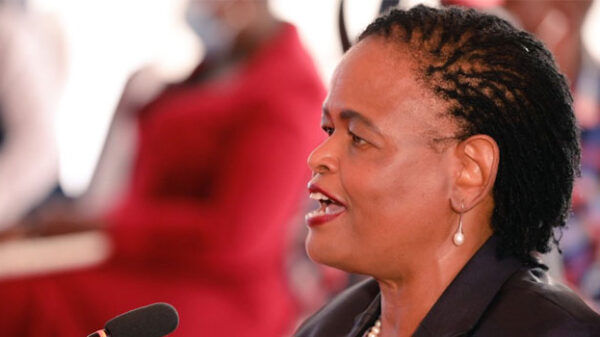It is a pleasure to address you today, as we gather to reflect on the performance of the High Court and our collective commitment to realise the goals that underpin our institutional vision of ‘Social Transformation through Access to Justice (STAJ)’.
This Annual High Court Leaders Conference, bringing together the Principal Judge, Presiding Judges of the various Stations and Divisions of the High Court, the Acting Registrar and the Deputy Registrars, is an ideal opportunity for us to reflect on how to position the High Court of Kenya as an anchor for the social transformation aspiration of the 2010 Constitution.
Pursuing this goal is tied to the core principle of STAJ which is the principle of ‘shared leadership’. Shared leadership means that leadership in the Judiciary isn’t about one person at the helm, rather it is about each one of us taking up the mantle, driving our shared vision, and bringing about transformation in our respective capacities.
As leaders of the High Court, you are called upon to be the drivers of STAJ in our court stations and divisions. We must not merely be its administrators, but its champions, advocates, and custodians.
In embracing shared leadership, we as High Court leaders must be the drivers of our shared vision and shared priorities. In addition, shared leadership means shared implementation. Each of us must take ownership of our roles, understanding that the success of STAJ is not solely dependent on the individual, but on the collective. Embodying shared leadership also means embodying a culture of proactive leadership.
This means that as Leaders of your court, you must embrace the view that leadership is not just about reacting to situations, it is about anticipating challenges, preparing for changes, and being ready from the front, setting an example, and motivating others to follow suit. It is in this way that your court stations and divisions can emerge as model courts of excellence.
Our journey towards deepening access to justice through the High Court is not a future aspiration. It is a present reality. The milestones we have achieved thus far, and the milestones we continue to aim for, stand testament to our steadfast commitment to bringing justice closer to the people.
Today, we have 47 High Court Stations and Divisions, with 79 Judges, serving 41 Counties. This impressive footprint is the result of relentless efforts and unwavering dedication to our cause. And we are not stopping here. In the remaining 6 counties – Elgeyo Marakwet, Isiolo, Lamu, Mandera, Samburu and Wajir – we have already established sub-registries in Isiolo, Elgeyo Marakwet (Iten), and Lamu. We are therefore on track to realise the aspiration of having a High Court in every County.
Our vision just doesn’t stop at geographical expansion, it extends to infrastructural advancements as well. As a testament to this, I will be opening the Siaya High Court building next week. I will also formally open the Ol Kalou High Court building in the coming term. This will ease the congestion at the Nyahururu Law Courts and allow us to invest more space on multiple doorways of justice such as mediation and AJS.
This, together with other ongoing building projects across the country are not just new buildings; they are a symbol of our commitment to enhance the physical accessibility of justice. Furthermore, in our quest to make justice more accessible, we are leveraging on ICT.
Our virtual Courts and e-filling system are potent tools in our arsenal. They have the power to bridge distances, transcend barriers, and bring justice to the doorsteps of our people. I urge all the High Court leaders to be the champions of these ICT-based initiatives. Embrace them, drive them, and promote them within your respective jurisdictions.
Your leadership and commitment to these initiatives will be instrumental in ensuring their success. We launched e-filling in Mombasa County last month, after the previous roll out in Nairobi County, and the response and uptake of the service is overwhelming.
We are now ready to roll out e-filling across the country, starting with Siaya, Kisumu and Homa-Bay Counties next week. This will be followed by Turkana, Samburu, Kiambu, Wajir, and Mandera in July and August. By February 2024, as per our workplan, e-filling will be operational in all our Courts countrywide.
I urge you to support these initiatives, given that each new court building we inaugurate, each new County that we reach, each new court station where we launch e-filling system, brings us closer to realise our vision of facilitating access to justice for our people. One of our key strategic objectives under STAJ is to attain ‘court excellence in productivity’.
I am happy to share that the High Court is making tremendous progress towards this objective. By the end of the third quarter of the Financial year 2022/23, the High Court had resolved a total of 27,396 cases, achieving a Case Clearance Rate (CCR) of 123%. This represents more than just numbers; it represents the Court’s unwavering commitment to expedite the dispensation of justice.
I want to applaud the Milimani Family Division and the Milimani Commercial and Tax Division for leading the pack with their impressive Court Clearance Rates of 127% and 166% respectively. However, we still have work to do. At the end of the same period, we had 84,082 pending cases in the High Court. Of these, 19,802 cases have been pending for over three (3) years, beyond our STAJ target.
This is an issue that demands our attention and innovative solutions. I urge this Conference to brainstorm strategies targeting the swift resolution of these 19,802 cases. This will not only improve our productivity but also enhance public confidence in our justice system.
I want to commend the Kitale High Court for leading the way with the highest merit productivity, having handled 478 cases. Your efforts are a shining example of what we can achieve with dedication and hard work.
With respect to our ‘no adjournment policy’ which is a critical aspect of our quest for efficiency, our goal is to ensure that we minimize adjournments to the greatest extent possible.
On this front, I would like to recognize and applaud the Kapsabet, Kisumu, Milimani Judicial Review Division, and Nyandarua/Nyahururu High Court Stations for recording the least incidents of adjourned cases.
While we celebrate these achievements with respect to our productivity, let us remember that they are not our destination, but stepping stones on our journey towards realizing our shared Vision. We have made great strides, but we have not yet reached our goal.
So, let us press on, by embracing initiatives that can help us improve on our efficiency and productivity. The High Court Leaders Conference is also an opportunity for us to reflect on how the High Court can be the driver and the face of the people-centred justice system that we seek to put in place under STAJ.
Let us use this Conference to reflect on the question: What must we do for the High Court to be said to embody a people-centred approach to the delivery of justice? In my view, it means that the High Court must reshape its work methodologies, both at the Registries and in Court proceedings, to be responsive to the justice needs of the Kenyan people. What this means is that we must be user-centred.
Being user-centred is not just about providing a service; it’s about understanding the unique needs and aspirations of those we serve. I therefore challenge this gathering to rethink how the High Court serves its users and responds to the unique justice needs of its users with a view to coming up with ways through which we can improve user experience. Let us work towards making Court Users to associate the High Court with being a trusted institution that is a beacon of hope to their justice problems.
To truly become user-centred, we must also become data-driven. Data allows us to identify patterns, spot trends, and understand our impact in real-time. With it, we can bridge the gap between the justice system and the justice needs of our people. The justice pathway must be navigated using the compass of data, allowing us to address and pre-empt bottlenecks, anticipate shifts in the justice landscape, and tailor our services accordingly.
This is why for example when we deployed Judges after the recent recruitment of more High Court Judges, we used case load information, including work load analysis to target areas with high caseloads, for equal distribution of work.
Similarly, the Finance Directorate is using data as a tool for determining financial allocations. Therefore, I urge you to ensure high equality and accuracy of the data at the court level when they are fed and captured in the Case Tracking System (CTS). In this regard, I congratulate the Principal Judge, the Registrar and all of you brother and sister Judges for supporting the High Court Case Census.
This exercise has set the pace for proactive data accuracy across the entire Judiciary. I have to add that being data-driven and user-centred is not enough; we must also be solution-oriented. Our mandate is to resolve disputes, and we must do so in a manner that not only addresses the immediate issue at hand, but also contributes to the larger goal of social transformation.
As the leaders in our diverse stations, it is incumbent upon us to embrace this approach and lead our teams in adopting the same. We should use this conference as a platform to identify and implement strategic game changers, to enhance performance, efficiency and expedite the delivery of our services.
The High Court must strive to be a breeding ground for innovation, a pioneer in implementing cutting-edge technologies, and a champion of procedural improvements.
I urge you to work towards scaling up game changers like the promotion of court annexed mediation, arbitration, and alternative justice systems (AJS). We must also support our initiative to leverage on technology as a driver of our efficiency. People-centred approaches such as accelerated service cards for the vulnerable speak to the soul of our shared vision.
We must do everything to bring justice closer to the most marginalized. Justice, not just in the procedural aspect, but rather, justice in the lived realities of modern-day societies. Justice, as the guardian of all human dignity.
Our justice system should never be a trauma-inflicting ground, rather, a place where the society can find redress and ways to build peace and cohesion. I also know that there are court specific or division specific innovations that you have come up with to improve on how you deliver justice, and I urge to continue with such initiatives and scale them up. In this way, our High Court stations across the country, and all the divisions of the High Court, will embody people-centred approach to the delivery of justice and act as catalysts for transformative justice.
I implore us to pay a keen attention to frontline justice services in order to address the immediate touchpoints where our users interact with the justice system. These services are crucial, and any enhancements or improvements we make to them will have a direct impact on the experience and perception of justice in our country. This is why it is vital that we continually strive to improve and refine these services.
We need to bridge the gap between our Court User Surveys and outcomes from engagements with Court User Committees (CUCs) and Bar-Bench meetings, and our policy and strategic direction. It is not enough to just listen to our users; we must translate their concerns, expectations, and aspirations into actionable plans. This demands active engagement and consistent feedback mechanisms. It necessitates open and inclusive dialogue that gives every user a voice and ensures that voice is heard.
With the insights gained from these engagements, we can begin to orient our registries to better serve vulnerable groups, and promote efficiency in our courts and registries.
As we strive for social transformation through access to justice, let us not forget that the bedrock of our profession is founded on integrity and accountability. As High Court Leaders we are not just responsible for dispensing justice, but also for championing the highest levels of integrity and accountability within our ranks. We must persistently champion our aspiration of ‘judicial hygiene’, which is about keeping our judicial house clean. It is about ensuring that every corner of our system is free from the dirt of corruption, and every inch of our operation is spotless in terms of integrity.
In this respect, I urge the High Court to fast-track the implementation of the recommendations from the Corruption Risk Assessment as contained in the Report on Systemic Audit of Our Registry Operations by the EACC that we launched last month.
Drawing from the investigations and pending complaints at the JSC and the Office of the Judiciary Ombudsperson, I urge all judges to exercise extra caution and balance when dealing with those tasked to support them. I recognize the critical support extended by staff but the sad reality is that some of those tasked with supporting us do use their office for profit.
I have received disturbing complaints about staff who abuse their offices and mis use information they have accessed in the course of their employment. Staff who have served in the same position and station for long periods are especially susceptible.
To remedy this, I have already directed the Hon. Chief Registrar to conduct a staff audit with a view to identifying such staff and I have put in place corrective measures to ensure periodic rotation of all staff. I call on your support to ensure success of the exercise.
As the supervisors of the subordinate courts I urge you to set good examples by having strong principles and strict adherence to the code of conduct. There is also the persistent problem regarding delayed determination of suits, we have continued to ensure Judges are well facilitated and supported to ensure they are able to make considered determinations; and develop jurisprudence necessary in our democratic society.
But we are facing challenges on delay. And the delay is in two categories; delay in delivery of judgments where in some cases the delay is for a period exceeding three years. Statute prescribes the period/time to be taken to prepare decisions. I see no reason why judges are not complying/should not comply with those timelines.
A second and relatively new kind of delay, is that of delay in availing pronounced decisions. The reality is that there are litigants in our corridors searching for decisions delivered months earlier. This situation cannot continue. As leaders we have a role to play and ensure good management of cases to avoid building up huge backlogs of pending determinations.
Furthermore, we need to foster an environment of continuous learning and development within the Judiciary. Mentorship and peer review programmes can play a crucial role in this regard. These platforms can serve as a melting pot of ideas, experiences, and wisdom.
They can provide guidance for our younger colleagues, foster a culture of mutual learning, and ensure the continuous innovations and improvement with respect to our judicial practices. By supporting mentorship and peer review, we can ensure that no one in the Judiciary walks alone, and that each step we take is taken together.
In this respect we are working on establishing a platform for Dialogues Across Courts Conversations, this will enable the High Court Judges to have a sit down with Judges of the Court of Appeal to understand each other and have a meeting of minds and hearts on emerging jurisprudence. The same will also be done with other courts like the Supreme Court, and the Specialised Courts, the ELC and ELRC.
We are also working towards addressing your welfare concerns. I have appointed an inter-agency Judges Retirement Benefits Bill Taskforce, headed by Hon. Justice William Ouko, which is working towards facilitating the enactment of the long-delayed Judges Retirement Benefits legislation.
As I conclude, let me draw your attention to the fact that we are now transforming the STAJ vision into a Blueprint to guide the Judiciary’s transformation initiatives going into the future. We are keen to ensure that the Blueprint should reflect the aspirations and dreams of all of us within the institution. We have therefore embraced a participatory process to give everyone within the institution an opportunity to tell us what initiatives and interventions they want to see the institution pursue going into the future.
Pursuant to this, there is a short questionnaire (also accessible from a QR Code) that will be going around that we urge you to fill to enable us get your feedback on which initiatives or priority areas you would like to see the institution focusing on.
Lastly, as the custodians of justice, we must remain ever mindful of our purpose and promise. Let us use this conference to refocus, reimagine, and recommit ourselves to the cause of justice.
Let us ensure that the High Court of Kenya is a beacon and a symbol of social transformation and an embodiment of our commitment to the people we serve. Together, let’s create an ecosystem where a court user leaving our courts says that she has been to a registry or a court that truly embodies ‘Social Transformation through Access to Justice’.
In this way, we will reshape the course of our nation’s destiny, one case at a time. Thank you and God bless you.
(This speech was delivered by Hon. Justice Martha Koome, EGH – Chief Justice & President of The Supreme Court of Kenya on June 7th 2023 during the 2023 High Court Leaders Conference)
























































